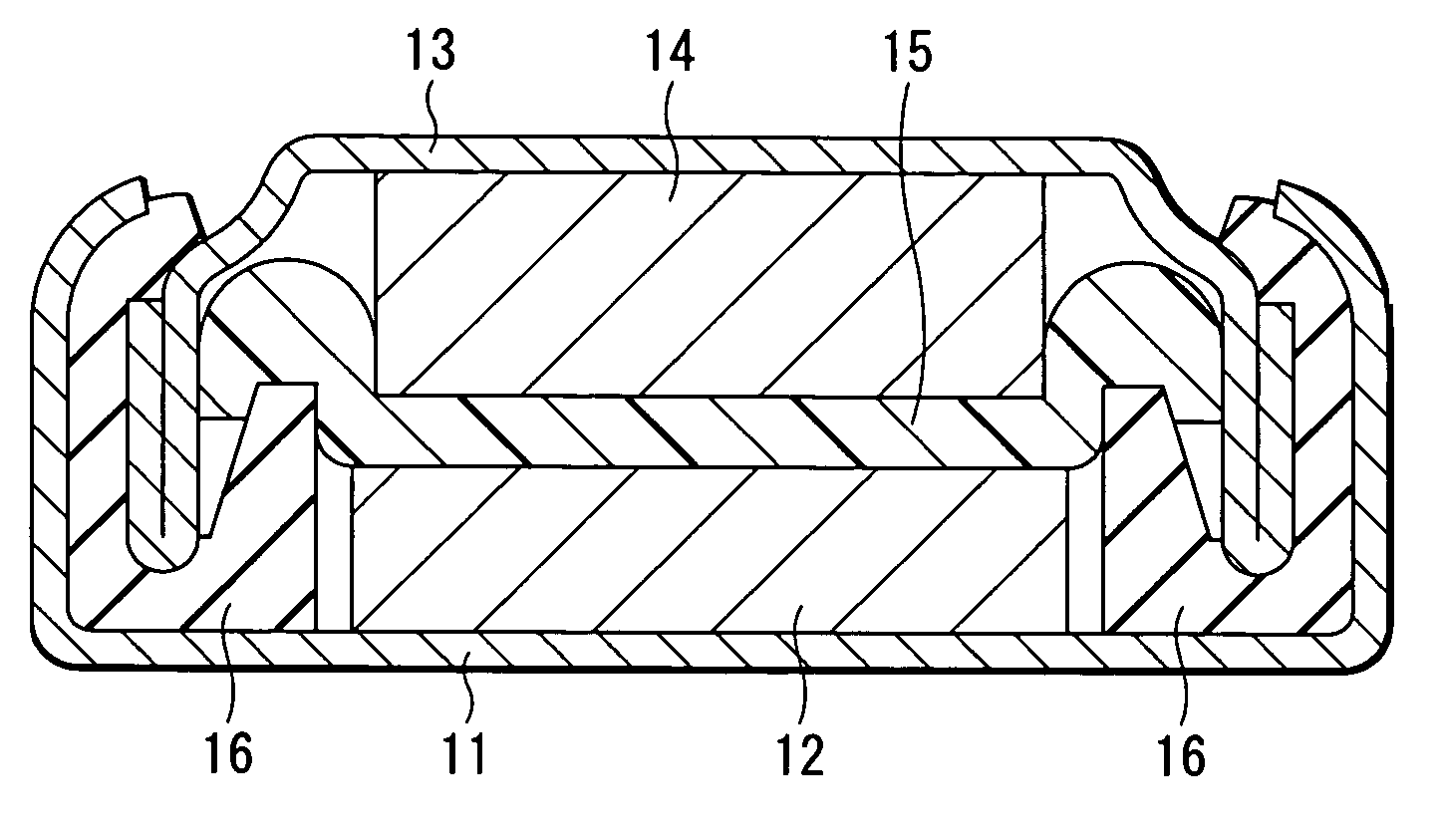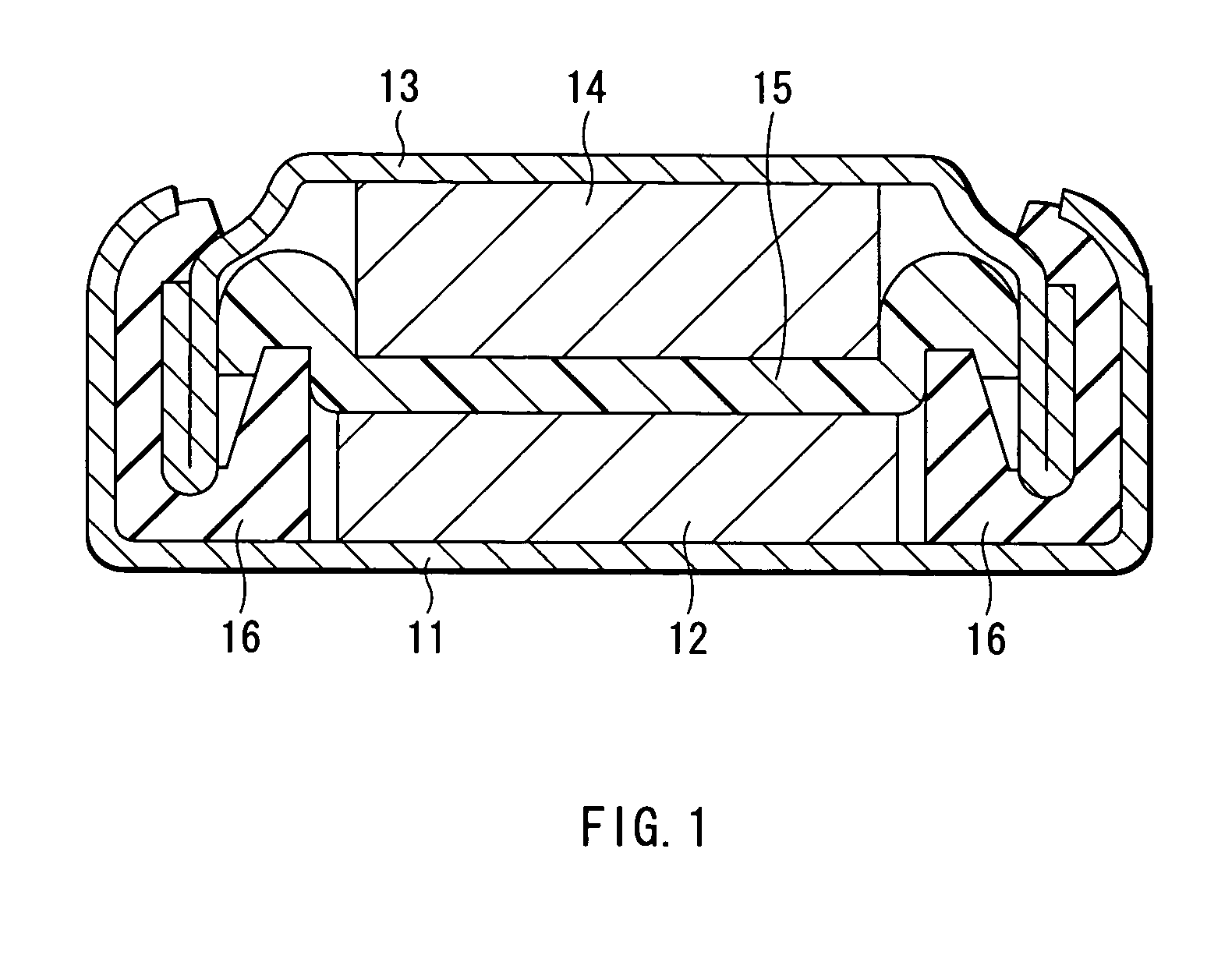Battery
a battery and composite oxide technology, applied in the field of batteries, can solve the problems of reducing the energy density of lithium composite oxide, and hardly satisfying the ever-increasing demands of energy density at 4.2 v or less
- Summary
- Abstract
- Description
- Claims
- Application Information
AI Technical Summary
Benefits of technology
Problems solved by technology
Method used
Image
Examples
first embodiment
[0012]FIG. 1 shows a cross sectional view of a secondary battery according to a first embodiment of the invention. The secondary battery is a so-called coin type and a laminate of a disk-like cathode 12 housed in a package can 11 and a disk-like anode 14 housed in a package cup 13 with a separator 15 sandwiched therebetween. Peripheral parts of the package can 11 and the package cup 13 are sealed and caulked with an insulative gasket 16.
[0013]The package can 11 and the package cup 13 are independently made of a metal such as stainless steel or aluminum (Al).
[0014]The cathode 12 is formed to contain a cathode active material, and if needed a conductive agent such as carbon black or graphite and a binder such as polyvinylidene fluoride. The cathode active material preferably contains a lithium composite oxide containing lithium, at least either cobalt or nickel, and oxygen, because this provides a high battery voltage and high qualities in invertibility, a discharge capacity, charge a...
second embodiment
[0050]A secondary battery according to a second embodiment of the invention is a so-called lithium secondary battery where a capacity of an anode is expressed by a capacity component by precipitation and dissolution of lithium. The secondary battery has the same structure as that of the first embodiment except for the anode composed of lithium metal or the like, and can be manufactured like the first embodiment except for using lithium metallic foil as the anode, for example. Therefore, it will be here described with reference to FIG. 1 using the same signs. In addition, detailed description about the same pats is omitted.
[0051]In the secondary battery, during the charging, the lithium ions are extracted from the cathode 12, and changed into metal and are precipitated on the anode 14 via the electrolyte with which the separator 15 is impregnated, for example. During the discharging, a part of lithium metal constituting the anode 14 changes into lithium ions, is eluted, and is insert...
third embodiment
[0053]According to a secondary battery of a third embodiment of the invention, a capacity of an anode includes a capacity component by insertion and extraction of lithium and a capacity component by precipitation and dissolution of lithium, and is expressed by the sum of them. The secondary battery has the same structure as that of the first embodiment except for a composition of the anode, and can similarly be manufactured. Therefore, it will be here described with reference to FIG. 1 using the same signs. In addition, detailed description about the same pats is omitted.
[0054]The anode 14 is formed to contain the anode material capable of the insertion and extraction of lithium, and if needed the binder.
[0055]The anode material capable of the insertion and extraction of lithium is relatively low compared with the cathode active material, and the lithium metal is precipitated on the anode 14 during the charging. Specifically, in a state where an open-circuit voltage is lower than an...
PUM
| Property | Measurement | Unit |
|---|---|---|
| battery voltage | aaaaa | aaaaa |
| concentration | aaaaa | aaaaa |
| molecular weight | aaaaa | aaaaa |
Abstract
Description
Claims
Application Information
 Login to View More
Login to View More - R&D
- Intellectual Property
- Life Sciences
- Materials
- Tech Scout
- Unparalleled Data Quality
- Higher Quality Content
- 60% Fewer Hallucinations
Browse by: Latest US Patents, China's latest patents, Technical Efficacy Thesaurus, Application Domain, Technology Topic, Popular Technical Reports.
© 2025 PatSnap. All rights reserved.Legal|Privacy policy|Modern Slavery Act Transparency Statement|Sitemap|About US| Contact US: help@patsnap.com


